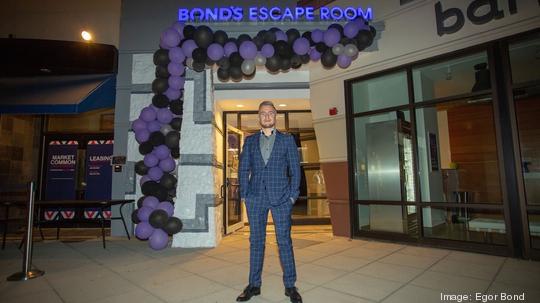
About the business: Bond’s Escape Room claims to be the largest on the East Coast, with 9,000 square feet in Fairfax and 4,000 square feet in Clarendon. Amid the pandemic and an initial slowdown in escape room business, founder Egor Bond launched a 3D printing company out of his Fairfax space. It started with a single printer — they now have 14.
How it started: Bond was born and raised in Siberia, before moving to Moscow to study innovation and logistics at the State University of Management. He immigrated to the United States in 2012, working for a couple years for a dental business. But that was just biding time until the opportunity arose to launch a company of his own.
Around 2015, he landed on escape rooms — just before their proliferation across the country.
“You can’t go wrong in investing in entertainment,” Bond said.
What started as a $30,000 investment has grown to two locations and, at its peak, $1.5 million in annual revenue.
The Fairfax space, at 3949 University Drive, offers nine escape rooms, making it the second largest in the country, Bond said. That building also houses Bond’s offices, meeting rooms and workshop, as Bond’s team creates all their own experiences.
The Clarendon space offers five escape rooms and a sixth “Art Attack” experience that mixes traditional escape with a paint “splatter room.”
Pandemic effect: During the initial months of the pandemic, even after the initial lockdown, consumers were largely not venturing out for experiential retail. It wouldn’t last forever, but it did knock the escape rooms for a loop, dropping 2020 revenue to $500,000, Bond said.
“Either we were closed or nobody wanted to come and play,” Bond said.
A month into the pandemic, he started weighing options. As the escape room reopening kept getting pushed back, that effort took on greater importance.
“What if the escape room is no longer there? What if it’s no longer meant to work as it did before?” Bond asked. “I started to think of what else could I dedicate myself to.”
Pandemic pivot: Like he did with escape rooms, landing on a trend shortly before it explodes in popularity, Bond saw 3D printing as a next frontier. He had ample space in Fairfax and a staff of six — plus four contractors — who accepted the new challenge. With an initial investment of $65,000, Bond’s 3D studio was off and running, producing everything from lifelike replicas of a consumer’s favorite canine to a measuring cup for the blind.
“Whatever you imagine in your head, this is something that can become physical,” Bond said.
The escape room business did return — to $1.5 million in 2021 revenue, Bond said. But he knows this entertainment trend will not last forever. They never do.
“At some point escape room will not be as relevant,” Bond said. “3D printing is going to be here for some time. It will last for many many many years. It will eventually grow over what escape room is.”
The challenge: The major challenge came around Christmas when demand soared for 3D printed gifts. At that point, Bond said, he needed to better organize and systemize that end of the business, from basic operations and accounting to converting leads.
“There is nothing too special about it," he said. "It’s something I have to overcome once for business to operate in that mode on a permanent basis.”
What’s next: While it’s not there yet, Bond expects, at some point, for 3D printing to overtake escape rooms as his main source of revenue. In the meantime, he continues to look for ways to grow the entertainment end of the business.
For example, pre-pandemic 20% of Bond’s Escape Room revenue came from corporate clients, “which we permanently lost because companies stopped coming inside locations to play games,” Bond said. So he created online team building activities, one called The Global Domination and the other The Corporate Conundrum, which cost from $350 to $750, to fill the gap.
A second line of potential business: in school. Bond’s team worked with Matt Hoffert, an after school program specialist at Fairfax County’s Luther Jackson Middle School, to build the first in-school escape room — possibly the first anywhere, Bond said — and he sees the potential for more.
Email mneibauer@bizjournals.com to share your business with us.